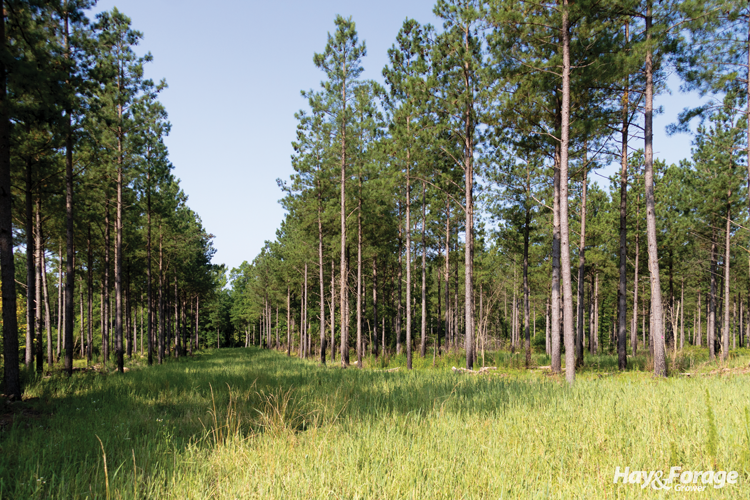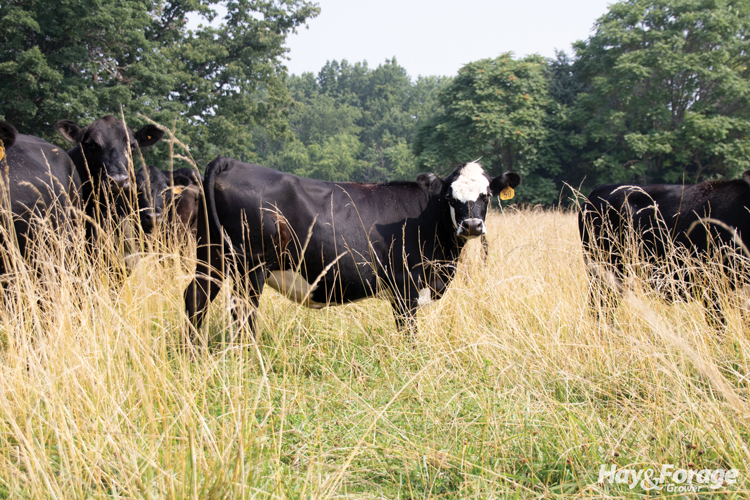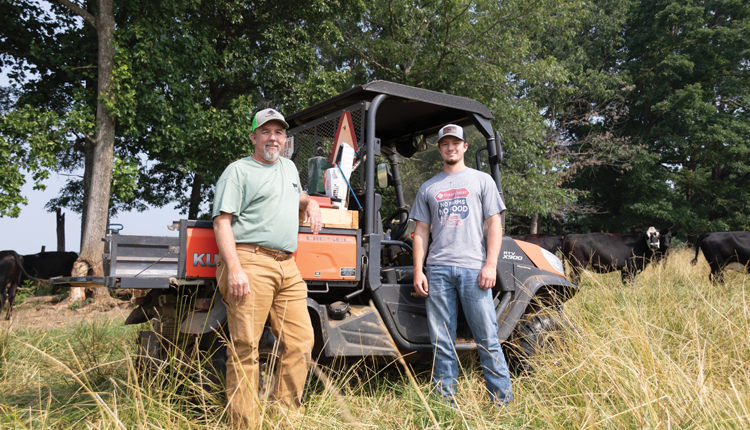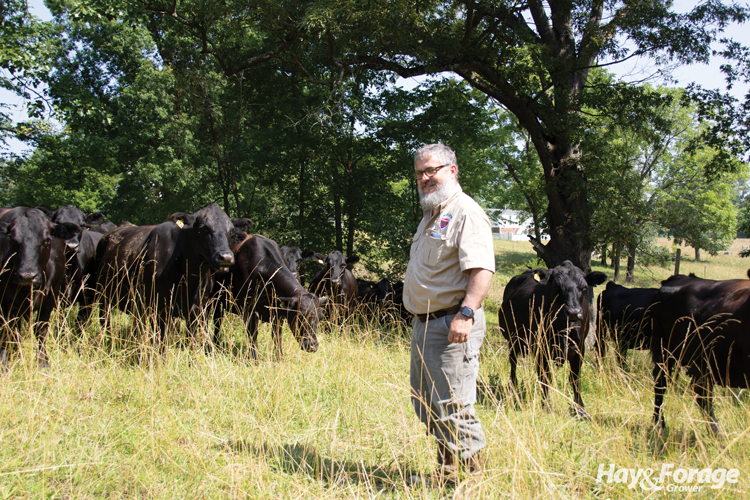
Several out-of-state license plates cruise through Moneta, Va., in the summertime as drivers head toward Smith Mountain Lake for a weekend getaway. As they near the scenic vacation spot, tourists likely pass by several pastures of beef cattle. One such herd belongs to Keith Tuck, whose farm is sandwiched between the small town and the lake’s shoreline.
Tuck was born and raised on the farm his grandfather purchased in 1962. Back then, the family primarily grew tobacco and had a small beef herd. In 2000, the labor demands of tobacco production became too tiresome, so Tuck turned his focus to forage. He established permanent pastures of Kentucky-31 tall fescue on about 250 acres and his vision for a rotational grazing system slowly came to fruition.
With support from Natural Resources Conservation Service (NRCS) cost-share programs, Tuck built exclusion fences around his streams and waterways. Then he put up a fence around the perimeter of his property and created 8- to 12-acre sections within the pasture. He also installed water troughs between every two to four paddocks. “I couldn’t start my rotational grazing system until I had all of this infrastructure,” said the former president of the Virginia Forage and Grassland Council. “Then I just expanded from there.”

With the infrastructure in place, Tuck started to improve his grazing practices to boost his beef production efficiency. He began stockpiling forage in the fall to minimize hay feeding and frost seeded red and white clover to dilute the toxic tall fescue. Tuck also converted some of his acres to native warm-season grasses to bolster summer forage supplies. By combining these strategies, he has been able to graze cattle approximately 300 days a year and was a regional winner of the National Cattlemen’s Beef Association’s 2023 Environmental Stewardship Award Program.
Filling the gaps
With help from his son, Andrew, Tuck maintains a fall-calving herd of about 80 Angus-cross cows, and they raise all of their own replacement heifers. In early September, he moves cattle to designated paddocks and starts to stockpile forage. Meanwhile, he unrolls large round bales of hay for cows to strip graze during the calving season. Tuck stopped making his own hay years ago because he finds it more profitable to buy it from local producers.
“I feed hay at this time so I can keep cattle on one or two fields when it isn’t too wet and they don’t tear the ground up as much,” he said. “The temperatures are comfortable when I unroll hay and I’m out checking for calves every day anyway.”
Sometime in November, Tuck begins strip grazing the stockpiled tall fescue. He gives cattle enough forage for about one to two days before moving the line of polywire ahead. This lasts animals through winter and early spring until pastures green up in April.

“When I start grazing again, the grass is coming up kind of slow, so I flash graze each field. I just take cattle through and let them nip the grass off quick before moving them to the next paddock,” Tuck said. “By the time they come back around, I can slow down the rotation because the grass is really starting to grow well.”
This steady spring growth comes to a halt when tall fescue hits its summer slump. While Tuck used to feed hay when forage production tapered off, he discovered an alternative approach to meeting feed demands by grazing native warm-season grasses.
“We usually get really dry in July and August, and the lake seems to change the weather pattern so that any precipitation skips around me,” Tuck said. “The native grasses give me a lot of grazing days because they grow when there is little rain and it’s really hot.”
Establishment year
To convert parts of his pastures to native warm-season grasses, Tuck terminated three existing tall fescue fields one year in the fall. Instead of planting a smother crop, he let the field fallow and then sprayed regrowth and weeds again in late March just prior to planting.
Tuck seeded one 16-acre paddock to switchgrass and two other 20- and 7-acre paddocks to a mix of big bluestem, little bluestem, and indiangrass. Once the seedlings were established, he waited another year before grazing cattle on the new forage to ensure it developed a strong root system. Tuck did not apply fertilizer to the new stands, but he did clip pastures one time to eliminate competition from weeds and allow more sunlight to reach the young plants.
The following year, Tuck introduced cattle to the switchgrass stand in late May. The growing points on switchgrass stems are much higher than that of tall fescue, so he moved animals along in the grazing rotation when plants were 8 to 10 inches tall. “That was hard to do because you think, ‘Man, they are leaving a lot out there,’ but you have to do it because the plants won’t survive if you graze them too close,” Tuck said from experience.
Cattle then worked their way through the mix of big bluestem, little bluestem, and indiangrass as well, completing a total of four rotations through the native warm-season grass stands that summer. These species start to go dormant by early September, which brings Tuck back to stockpiling tall fescue and unrolling hay.
Another adopter
Before proceeding with planting, Tuck invested in a drill specifically designed for native grass seeds since they are especially small and fluffy. He made a point to buy a seeder that was only 8-feet wide and would fit on the bed of his trailer so he could haul it to other farms and helping his friends establish stands of their own.
One of Tuck’s first custom seeding clients was Miller Adams. The area forester for Charlotte County grew up farming alongside his father and grandfather in Red Oak before attending Virginia Tech to study forestry. Then Adams returned home from college to help expand his family’s beef operation and develop a better grazing system.
Tuck made the two-hour drive from Moneta to Red Oak with his seed drill in tow to help Adams plant roughly 15 acres of big bluestem among three fields that were previously rooted in tall fescue. Instead of incorporating the forage into his grazing rotation, though, Adams planned to harvest the big bluestem for hay.
“I was trying to develop that land as an area where I could harvest hay outside of the timeframe that we would harvest tall fescue hay. Our windows of opportunity to do so are so small in the spring because we can have a thunderstorm come out of nowhere. I thought moving toward a native warm-season grass might be a good idea,” the problem-solving producer said.

Adams’ family transitioned away from growing tobacco and raising dairy cattle to grazing beef cattle about 30 years ago. Like Tuck, he now has a herd of approximately 80 crossbred cows that calve in the fall. Adams uses polywire fences to create temporary paddocks in his 200 acres of pasture, and even though the asphalt road that cuts across his property might seem like it would interfere with his grazing goals, he has learned to use the dividing line to his advantage.
Around the end of August or early September, Adams corrals his cattle to the north side of the road and starts stockpiling tall fescue to the south. Cows continue to move through paddocks before he begins feeding them hay as calving season commences. Adams used to unroll large round bales of hay but has recently been leaving bales intact and setting several of them upright across the field.
“It has been a tremendous benefit to put bales out there ahead of time compared to having to get in the tractor and carry hay sometimes twice a day,” Adams affirmed. “I put out six or seven bales at a time, which lasts the herd about two and a half days. I watch them to see when they need more forage, then I take down the fence and give them a new section.”
By January, calves are big enough to follow the cows back across the road to strip graze the stockpiled forage to the south, and this lasts them until spring when they can begin rotationally grazing fresh forage again.
Switchgrass in silvopasture
In addition to baling big bluestem and stockpiling tall fescue, Adams has started grazing cattle on switchgrass in a silvopasture system. In 2016, he purchased a plot of land that was partially planted to loblolly pine trees for timber production. He converted the open grassland to a novel-endophyte variety of tall fescue and experimented with silvopasture management in the wooded areas.
Adams contracted a logger to harvest alternating 50-foot corridors across about 20 acres of the tree stand. The logger also performed a heavy commercial thinning in the remaining trees to reduce the stand density by about one-third so sunlight could reach the forest floor. Adams then administered several prescribed burns to manage the accumulated debris and remove the duff layer, and he hired the use of a forestry tiller to grind down the stumps that were left behind after the tree harvest.
Once the corridors were prepared for planting, Adams opted to seed switchgrass because of its ability to withstand the sweltering summers of southern Virginia. In fact, he was inspired to plant the native warm-season species because of the persistence of a patch of grass in his front yard.
“Just to the side of my mailbox, there is some switchgrass that is naturally occurring,” Adams said, pointing to the prolific plants. “One time we had a dry fall and all of my pastures turned brown, but that switchgrass continued to stay green with very little water.”
The refined forester also knew switchgrass would be better suited to the soil properties below the silvopasture as opposed to an improved variety of tall fescue. Although the soil would likely be very acidic after years of tree production, the native warm-season species is adapted to low soil pH.
Since its inaugural grazing event, Adams has integrated the switchgrass stand into his grazing rotation in the summer. In addition to its ability to grow in the heat and humidity, switchgrass has been shown to improve wildlife habitat. He noted its tight bunching growth pattern provides an ideal environment for ground-dwelling species like bobwhite quail.
Despite their different approaches to growing native warm-season grasses, both Tuck and Adams can attest to the value they bring to the table. Between filling the gaps in summer grazing and securing greater hay supplies, the two farmers have seen significant improvements in their beef production by integrating these species into their forage systems.
“I have had people ask, ‘Where did you get all that grass?’” Tuck laughed. “The native species help me rest my pastures and give the grass more recovery time. My cows look nice and plump because they have plenty to eat.”
This article appeared in the March 2024 issue of Hay & Forage Grower on pages 6-8.
Not a subscriber? Click to get the print magazine.

